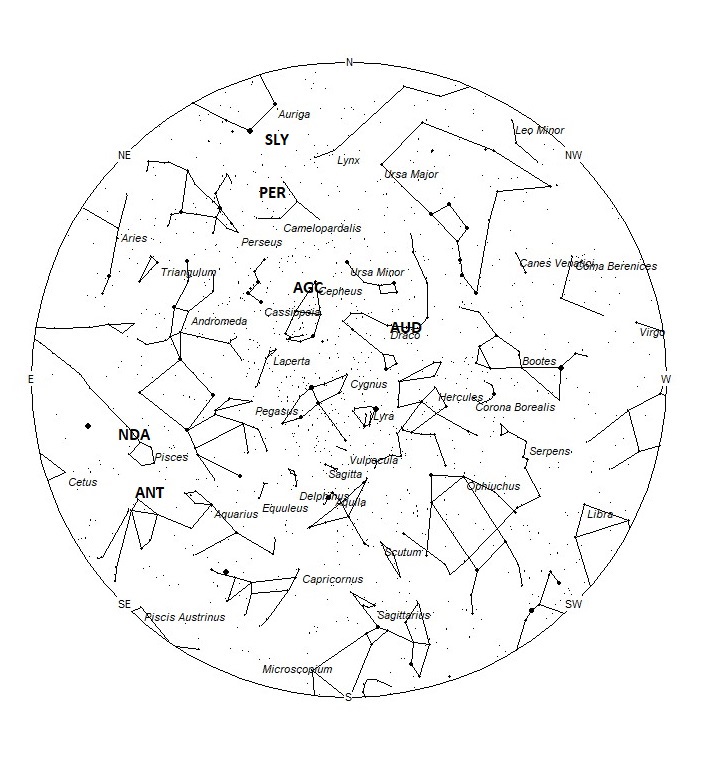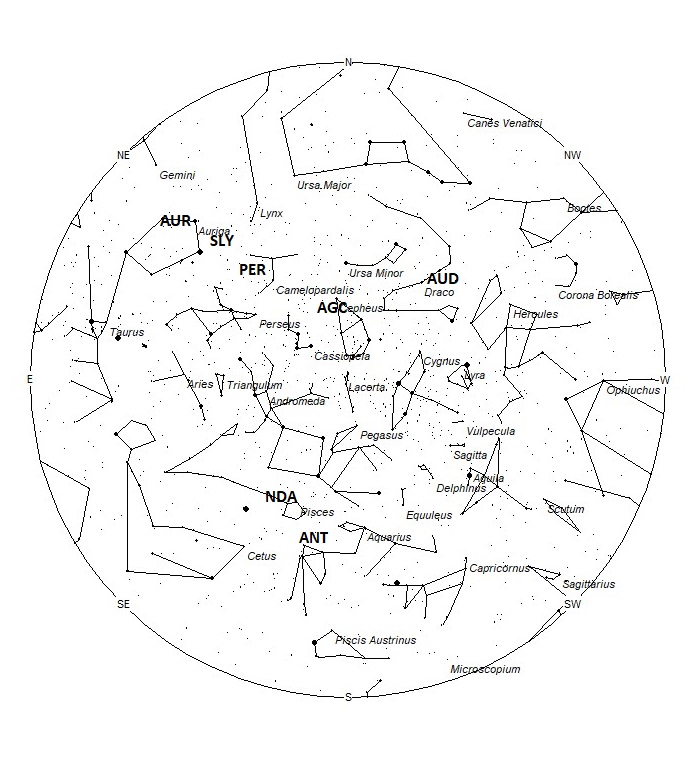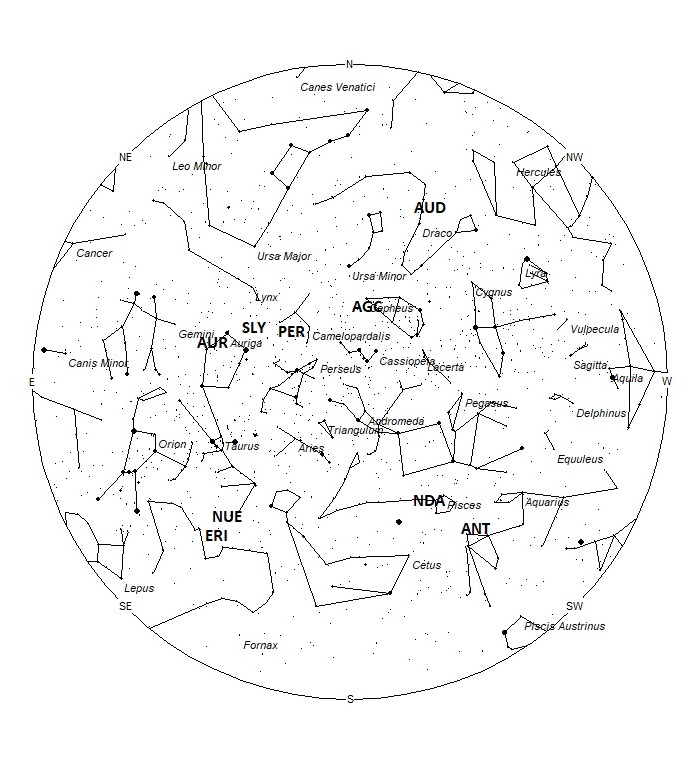During this period, the moon reaches its new phase on Saturday August 27th. At that time the moon will lie near the sun and will be invisible at night. As the week progresses the waxing crescent moon will enter the evening sky but will set long before the more active morning hours arrive. The estimated total hourly rates for evening observers this week should be near 4 as seen from mid-northern latitudes (45N) and 3 as seen from tropical southern locations (25S) For morning observers, the estimated total hourly rates should be near 16 as seen from mid-northern latitudes (45N) and 10 as seen from tropical southern locations (25S). The actual rates will also depend on factors such as personal light and motion perception, local weather conditions, alertness, and experience in watching meteor activity. Note that the hourly rates listed below are estimates as viewed from dark sky sites away from urban light sources. Observers viewing from urban areas will see less activity as only the brighter meteors will be visible from such locations.
The radiant (the area of the sky where meteors appear to shoot from) positions and rates listed below are exact for Saturday night/Sunday morning August 27/28. These positions do not change greatly day to day so the listed coordinates may be used during this entire period. Most star atlases (available at science stores and planetariums) will provide maps with grid lines of the celestial coordinates so that you may find out exactly where these positions are located in the sky. I have also included charts of the sky that display the radiant positions for evening, midnight, and morning. The center of each chart is the sky directly overhead at the appropriate hour. These charts are oriented for facing south but can be used for any direction by rotating the charts to the desired direction. A planisphere or computer planetarium program is also useful in showing the sky at any time of night on any date of the year. Activity from each radiant is best seen when it is positioned highest in the sky, either due north or south along the meridian, depending on your latitude. It must be remembered that meteor activity is rarely seen at the radiant position. Rather they shoot outwards from the radiant, so it is best to center your field of view so that the radiant lies at the edge and not the center. Viewing there will allow you to easily trace the path of each meteor back to the radiant (if it is a shower member) or in another direction if it is sporadic. Meteor activity is not seen from radiants that are located far below the horizon. The positions below are listed in a west to east manner in order of right ascension (celestial longitude). The positions listed first are located further west therefore are accessible earlier in the night while those listed further down the list rise later in the night.
These sources of meteoric activity are expected to be active this week.
.
The zeta Draconids (AUD) were discovered by Zdenek Sekanina in his study of meteor streams using radio methods. This stream is active from August 12-September 5 with maximum activity occurring on August 26. The radiant is currently located at 16:52 (253) +62, which places it in central Draco, 3 degrees east of the 4th magnitude star known as Athebyne (eta Draconis A). This radiant is best placed near 2000 local summer time (LST), when it lies on the meridian and is located highest in the sky. With an entry velocity of 21 km/sec., the average zeta Draconid meteor would be of slow velocity. Rates this week are expected to be less than 1 no matter your location. Due to the high northern declination these meteors are difficult to observe from the southern hemisphere. These meteors are synonymous with the August Draconids (AUD).
The large Anthelion (ANT) radiant is currently centered at 23:08 (347) -05. This position lies in northern Aquarius, 1 degree northwest of the 4th magnitude star known as phi Aquarii. Rates at this time should be near 3 per hour no matter your location. Observers concentrating on this activity should face high in the northern sky near 02:00 LST to best view these meteors. With an entry velocity of 30 km/sec., the average Anthelion meteor would be of slow velocity.
The August beta Piscids (NDA) are part of the Northern delta Aquariid complex, active from August 18-September 8. This second peak of the NDA’s occurs on August 21st, when the radiant lies well within the boundaries of the constellation of Pisces. The radiant currently lies at 23:52 (358) +07, which is located in western Pisces, 2 degrees west of the 4th magnitude star known as omega Piscium. To best see these meteors, face high toward the north near 0300 LST, when it lies on the meridian and is located highest in the sky. Hourly rates at this time should be less than 1 no matter your location. With an entry velocity of 38 km/sec., the average meteor from this source would be of medium velocity.
The August gamma Cepheids (AGC) are a recent discovery by Damir Šegon and the Croatian Meteor Network team based on studying SonotaCo and CMN observations (SonotaCo 2007-2011, CMN 2007-2010). Meteors from this source are expected from August 17 through September 6, with maximum activity occurring on August 29. The current position lies at 23:54 (359) +77, which lies in northern Cepheus, 1 degree southeast of the 3rd magnitude star known as Errai (gamma Cephei A). To best see these meteors, face low toward the north near 0300 LST, when it lies on the meridian and is located highest in the sky. Rates at this time should be less than 1 per hour as no matter your location. With an entry velocity of 44 km/sec., the average meteor would be of medium velocity. These meteors are not visible south of latitude 13 South.
The nu Eridanids (NUE) were co-discovered by Japanese observers using SonotoCo and Jürgen Rendtel and Sirko Molau of the IMO. Activity from this source stretches from August 31 to September 21. The main maximum activity occurs on September 11th. A secondary maximum occurs on September 17th. The radiant currently lies at 03:50 (058) -04, which places it in northeastern Eridanus, near the faint star known as 32 Eridani. Note that this position is close to the radiant of the eta Eridanids. One must face the radiants of these two sources to separate them. This area of the sky is best seen during the last dark hour before dawn when the radiant lies highest in a dark sky. Current rates are expected to be less than 1 per hour during this period no matter your location. With an entry velocity of 65 km/sec., the average meteor from this source would be of swift velocity.
The eta Eridanids (ERI) were discovered by the Tokyo Meteor Network back in 2001. The radiant is currently located near 03:57 (059) -07. This position lies in northeastern Eridanus, 6 degrees north of the 3rd magnitude star known as Zaurak (gamma Eridani). This source is active until September 10th, with maximum activity occurring on August 6th. Current rates would be less than 1 per hour no matter your location. Observers concentrating on this activity should face high up in the eastern sky during the last dark hour prior to dawn to best view these meteors. With an entry velocity of 64 km/sec., the average meteor from this source would be of swift speed.
The last of the Perseids (PER) are expected this week from a radiant located at 04:28 (071) +60. This position lies in southern Camelopardalis, 3 degrees west of the 4th magnitude star known as beta Camelopardalis. Current rates are expected to be near 1 per hour as seen from the Northern Hemisphere and less than 1 as seen from southern tropical locations. Observers concentrating on this activity should face half-way up in the northern sky during the last dark hour prior to dawn to best view these meteors. Observers in the northern hemisphere are better situated to view this activity as the radiant rises much higher in the sky before dawn compared to southern latitudes. With an entry velocity of 60 km/sec., the average meteor from this source would be of swift velocity.
The September Lyncids (SLY) are composed of two weak showers active throughout September. The earlier branch is active from August 30th through September 20th with maximum activity occurring on September 11th. The radiant is located at 05:42 (086) +52, This position lies in northern Auriga, 2 degrees northwest of the faint star known as omicron Aurigae. To best see these meteors, view half-way up in the northeastern sky during the last hour prior to dawn. Rates are expected to be less than 1 per hour. With an entry velocity of 62 km/sec., the average meteor from this source would be of swift velocity.
The Aurigids (AUR) are active from August 26 through September 4, peaking on September 1st. At maximum the radiant is located at 06:04 (091) +39. This position lies in eastern Auriga, 2 degrees northeast of the 3rd magnitude star known as Mahasim (theta Aurigae A). To best see these meteors, it is suggested to view half-way up in the northeastern sky during the last hour prior to dawn. Normally, hourly rates are less than 1 except on the night of maximum activity. With an entry velocity of 65 km/sec., the average meteor from this source would be of swift velocity.
As seen from the mid-northern hemisphere (45N) one would expect to see approximately 12 sporadic meteors per hour during the last hour before dawn as seen from rural observing sites. Evening rates would be near 3 per hour. As seen from the tropical southern latitudes (25S), morning rates would be near 7 per hour as seen from rural observing sites and 2 per hour during the evening hours. Locations between these two extremes would see activity between the listed figures.
You can keep track of the activity of these meteor showers as well as those beyond the limits of visual observing by visiting the NASA Meteor Shower Portal available at: https://meteorshowers.seti.org/ You can move the sky globe to see different areas of the sky. Colored dots indicate shower meteors while white dots indicate sporadic (random) activity. The large orange disk indicates the position of the sun so little activity will be seen in that area of the sky.
The list below offers the information from above in tabular form. Rates and positions are exact for Saturday night/Sunday morning except where noted in the shower descriptions.
| SHOWER | DATE OF MAXIMUM ACTIVITY | CELESTIAL POSITION | ENTRY VELOCITY | CULMINATION | HOURLY RATE | CLASS |
| RA (RA in Deg.) DEC | Km/Sec | Local Summer Time | North-South | |||
| zeta Draconids (AUD) | Aug 26 | 16:52 (253) +62 | 21 | 21:00 | <1 – <1 | IV |
| Anthelion (ANT) | – | 23:08 (347) -05 | 30 | 02:00 | 3 – 3 | II |
| August beta Piscids (NDA) | Aug 12 | 23:52 (358) +07 | 38 | 03:00 | <1 – <1 | IV |
| August gamma Cepheids (AGC) | Aug 29 | 23:54 (359) +77 | 44 | 03:00 | <1 – <1 | IV |
| nu Eridanids (NUE) | Sep 11 | 03:50 (058) -04 | 65 | 07:00 | <1 – <1 | IV |
| eta Eridanids (ERI) | Aug 06 | 03:57 (059) -07 | 64 | 07:00 | <1 – <1 | II |
| Perseids (PER) | Aug 13 | 04:28 (071) +60 | 60 | 07:00 | 1 – <1 | I |
| September Lyncids (SLY) | Sep 11 | 05:42 (086) +52 | 62 | 08:00 | <1 – <1 | IV |
| Aurigids (AUR) | Sep 01 | 06:04 (091) +39 | 65 | 08:00 | <1 – <1 | II |
Class Explanation: A scale to group meteor showers by their intensity:
- Class I: the strongest annual showers with Zenith Hourly Rates’s normally ten or better.
- Class II: reliable minor showers with ZHR’s normally two to ten.
- Class III: showers that do not provide annual activity. These showers are rarely active yet have the potential to produce a major display on occasion.
- Class IV: weak minor showers with ZHR’s rarely exceeding two. The study of these showers is best left to experienced observers who use plotting and angular velocity estimates to determine shower association. These weak showers are also good targets for video and photographic work. Observers with less experience are urged to limit their shower associations to showers with a rating of I to III.







